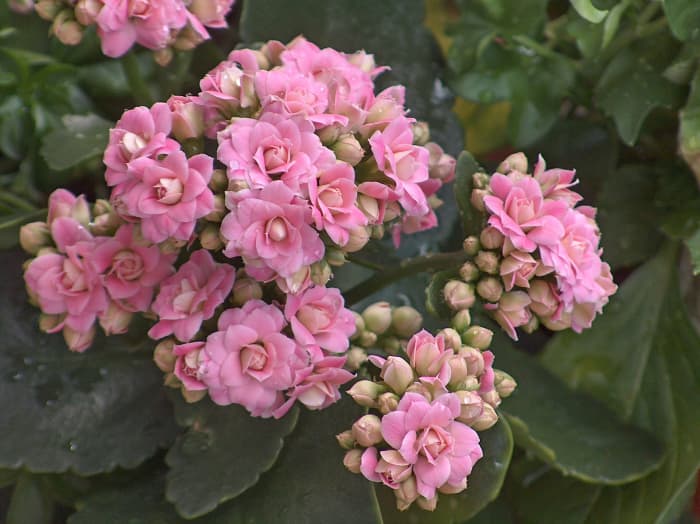Lockridge is an avid reader who enjoys learning about beautiful garden plants. Among other things, she has worked with a florist.
Although kalanchoe is typically grown as a houseplant, it can be planted outside in warm regions successfully. The kalanchoe is also commonly grown as a ground cover or planted in rock gardens for a nice splash of color. Group kalanchoe en masse for a striking color burst, or group several colors together for a colorful display.
General Indoor Care Instructions
- Select an east- or west-facing window during summer months and a south-facing window in the winter for your kalanchoe. Kalanchoe need plenty of light and may tend to look rather leggy if they don’t receive adequate light levels.
- Plant kalanchoe in potting soil designed for cacti or other succulents. If succulent soil isn’t available, consider adding sand or perlite to the soil to make the soil better draining. Maintain proper moisture levels (don’t water it too often) to keep your kalanchoe thriving.
- Monitor soil levels. Allow the soil to dry out between waterings. Add enough water to the container until water runs out of the bottom of the container. Pour any remaining water from the bottom of the container; kalanchoe don’t tolerate standing water.
- Fertilize kalanchoe when the plant is in bloom.
- Maintain the look of your kalanchoe by deadheading spent blooms. Gently wipe down leaves to remove dust.
How to Force Kalanchoe Blooms
You can force a kalanchoe to bloom by simulating winter-like conditions after exposing it to dark conditions for six weeks.
- Move the kalanchoe to an area receiving total darkness (such as placing a covering over the plant or setting it in a closet) for 14 hours a day and bright sunlight for 10 hours a day.
- Limit waterings at least half as often as you used to.
- Bring the plant back to normal light condition once you notice buds forming on the plant. Resume watering, and apply a well-balanced fertilizer to encourage bloom growth.
How to Plant Outside
The kalanchoe is native to tropical and subtropical climates and can be successfully grown outdoors in USDA hardiness zones 10 and 11. The plant blooms best in 65–85 degrees Fahrenheit and is quite susceptible to cold and frost.
- Select a planting location that will receive indirect sunlight. Kalanchoe exposed to too much direct sunlight will become damaged and dry out.
- Plant the kalanchoe in well-draining soil. Consider a 60:40 peat moss to perlite ratio to allow for periods of dryness. Only water the plant if the top 1 inch of soil is dry; kalanchoe are susceptible to root rot when exposed to standing water.
- Keep plants trim by deadheading blooms and cutting off leggy growth to keep the plant compact and growing upright.
- Fertilize once monthly during the growing cycle.
How to Propagate
- Cut a 4- to 6-inch piece from your kalanchoe plant and remove the lower leaves from the stem.
- Set the cutting aside for 1 to 2 days to allow the cut to scab over.
- Plant the cutting in a 3-inch pot filled with soil for succulents. Insert the stem so the remaining leaves are above the soil line. Water the plant regularly, only when the top 2 inches of soil are dry. Limit watering to avoid root rot.
- Expect rooting in about 2 to 3 weeks.
- Transplant the kalanchoe cutting to a larger pot once the plant is more mature.
Pests and Problems
Inspect your plant periodically for pests, such as aphids, spider mites, and scale. Look for torn or faded leaves. Apply neem oil and clean leaves to curb infestations. Leaf spot may be an indication of overly humid conditions.
Questions & Answers
Question: Are kalanchoe plants resistant to deer?
Answer: Deer will eat just about anything if they are hungry enough, but in general, they stay away from poisonous plants and those that are heavily scented. While I couldn't find anything specific to kalanchoe, I suggest visiting The Old Farmers' Almanac for a comprehensive list of plants that deer both like and dislike.
Question: Should I cut back my Kalanchoe's leggy portions?
Answer: Kalanchoe look more attractive when they are kept nice and trim. Cut back any leggy portions to help focus energy into other blooms and keep the plant growing upright and compact.
Answer: Regularly pruning kalanchoe is normal, and will encourage new growth. As long as the plant is still thriving I wouldn't be too concerned with some brown leaves, especially since you are seeing new growth. Monitor water and light levels closely, and good luck!
Question: What happens if kalanchoe is eaten by a child?
Answer: Kalanchoe is not poisonous to humans, however, they are toxic to pets.


Comments
Post a Comment